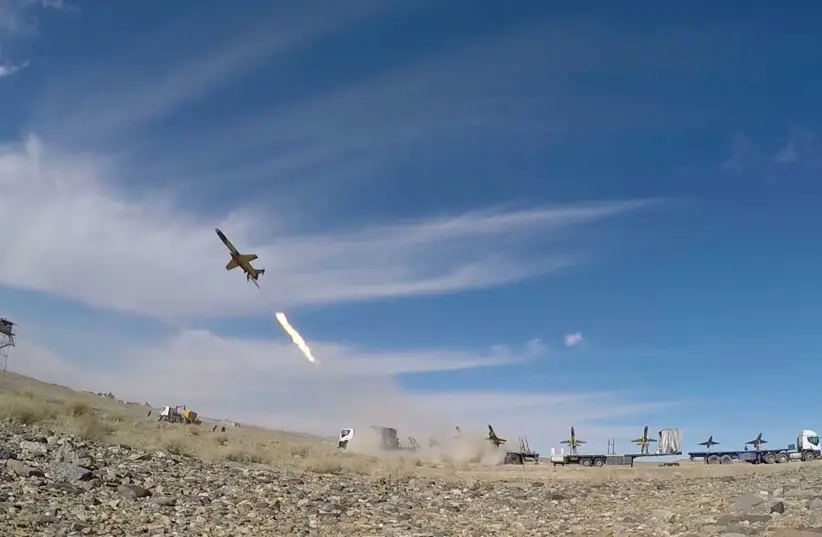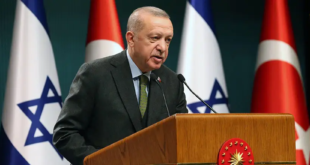A day before the attack, a shadowy group told Sabereen news that it had targeted “Mossad” in northern Iraq.
A drone attack last week on Erbil in northern Iraq’s autonomous Kurdish region has all the hallmarks of an Iranian-backed attack. Drones have been used by Iran’s proxies in Yemen, and Tehran has exported them to partners in Iraq, Syria and Lebanon.
Iran has a sophisticated series of drones, many of which are kamikaze drones that operate like cruise missiles. You put in coordinates and then send them on a mission. Iran also used drones in 2018 during a missile attack on Kurdish dissidents in Iraq, and as surveillance against ISIS in Syria.
What do we know about the attack on Erbil? It is the third attack on US-led coalition forces in the city. Pro-Iran militias in Iraq, led by Kataib Hezbollah, shifted tactics after 2019 and 2020 when US forces consolidated their facilities in Iraq, withdrawing from a series of smaller bases such as Q-West, K-1, Nineveh and even Tamp Taji. This left less targets for Iran’s militias in Iran’s neighbor to the west.
At the same time, those militias, called PMU and which also have political wings in the government and receive government salaries, have now been forced to use aliases.
There was an attack on Erbil in late September 2020 and another on February 15. The recent attack was likely a message to the US and the new Biden administration. Iran and its allies in Iraq want the US to leave.
The first attack on Erbil had followed dozens of other attacks. A US contractor was killed in December 2019 in Kirkuk and several force members were killed in Camp Taji in March 2020. The rockets fired in 2020 at Erbil were 122mm Grads that did little damage. However, the March attack included rockets falling on numerous warehouses and harming civilians and contractors.
THE DRONE attack is more mysterious. Not many details are known. The US-led coalition spokesperson has not released new details. “A drone packed with TNT targeted a coalition base at Erbil airport,” the Kurdish region’s Interior Ministry said in a statement. A pro-Iranian group calling itself Awliyaa al-Dam (Guardians of Blood), applauded the strike on the messaging app Telegram. Iraqi politicians pointed fingers at the pro-Iran militias and at “terrorists.”
Many leading Iraqi politicians are afraid of the Iranian-backed groups, which have threatened the president and prime minister in the past. The powerful Badr organization has tentacles in the Nineveh plains near Erbil and its 30th brigade of the PMU, a Badr affiliate, has hosted rocket-firing squads that not only targeted Erbil last year but also targeted a Turkish base on the same night as the drone attack.
In addition, on April 13 a day before the drone attack, a shadowy group told Sabereen news that it had targeted the “Mossad” in northern Iraq.
While many noted that the drone attack is likely linked to Iran, others also commented on how it is an escalation. “Suicide drones are particularly useful in these types of hits as they can avoid counter rocket, artillery and mortar systems such as C-RAM,” the system deployed by the Americans to protect their troops in Arbil and Baghdad, Hamdi Malik, associate fellow at the Washington Institute, told AFP.
The AFP report includes other important details. Not only is this the first drone attack on US forces in Iraq, but “this method is tried and tested for Iran-aligned groups in the region.” The article alleges that the attack was carried out by an Iranian-made drone having a 15-foot wingspan, similar to the ones used by the Houthis. They are known as Qasef-style drones.
THE US senior defense official who spoke to AFP linked this to a January attack on the royal palace in Saudi Arabia’s capital Riyadh, allegedly carried out from Iraq. “We know the attack was launched… out of southern Iraq,” added the US official, speaking on condition of anonymity.
That gives these drones a range of some 1,500 km. They use GPS as a guide and are pre-programmed. “They can even be loaded onto a ship from Basra” the report notes. In January another report indicated Iran may have supplied the Houthis with a drone that has a 2,000 km. range and can reach Israel.
What we know about the drone attack on Erbil now adds to growing evidence of Iran sending drones to Iraq and using them against Saudi Arabia and now US forces. For instance, in May 2019 it was believed that attacks on Saudi Arabia were planned by Iran using Iraqi soil. In February, AP noted that “explosive-laden drones that targeted Saudi Arabia’s royal palace in the kingdom’s capital last month were launched from inside Iraq, a senior Iran-backed militia official in Baghdad and a US official said.”
The US is clearly building a case against Iran for these attacks. But Washington already had a lot of evidence of Tehran’s role in drone attacks. At the so-called “petting zoo” at the Iran Materials Display at Joint Base Anacostia-Bolling, there were examples of Iranian drones. Details compiled by Conflict Armament Research already linked Iran via gyroscopes to drones used across the Middle East. Kurdish authorities have also investigated the February attacks that used rockets.
But despite all the investigations, little is done against the Iranian groups because everyone fears them. The US fears escalation, for instance.
The claim that drones can get around C-RAM pose another threat to American forces. The US sent Patriot air defense to Iraq in 2020 after the rocket attacks increased. C-RAM, a statistical weapon that fires massive numbers of rounds at an incoming munition, is also in Iraq to defend US bases. But these outdated air defense technologies have difficulty against drones, cruise missiles and even rockets.
Israel’s Iron Dome works much better against these new threats. The US has two Iron Dome batteries, but there is no evidence it will deploy them to Iraq.
 Eurasia Press & News
Eurasia Press & News




